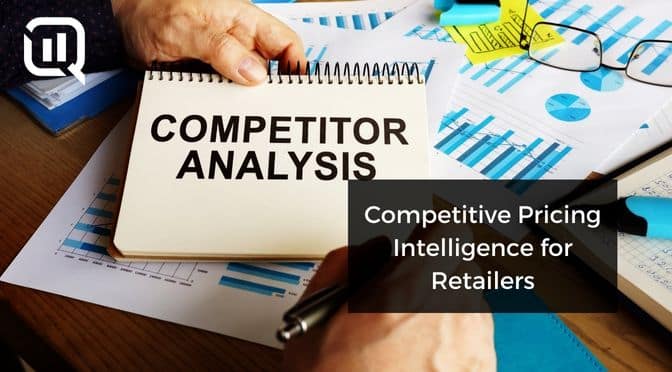In today’s increasingly competitive environment, retailers must stay ahead. Leveraging competitive pricing intelligence can be a winning strategy that enables retailers to offer customers the best value for their money and maximize their profits.
Price optimization requires a thorough understanding of the local and global markets, monitoring competitors’ prices, and staying current with changing trends.
What Is Competitive Pricing Intelligence for Retailers?
It’s no secret that competition is fierce in the growing global retail market. Online retailers need to employ competitive pricing intelligence (CPI) strategies to stay ahead of the game. In short, CPI is the process of understanding, anticipating, and responding to changes in competitor pricing quickly and efficiently.
CPI enables online retailers to remain competitive and maximize their profits by monitoring competitors’ prices and responding accordingly. It is an effective way to track competitors’ prices, analyze trends, discover new opportunities, and adjust their prices when needed.
With CPI, retailers can access the right price information to optimize their pricing strategies and gain a competitive edge in the market. CPI can help retailers maximize their margins and bottom-line profits.
How to Use Competitive Pricing Intelligence for Maximum Online Retail Success
When it comes to online retail success, competitive pricing strategies are key to success. This type of retail pricing intelligence allows retailers to track and compare prices with their competitors to remain competitive.
Using competitive pricing, e-commerce retailers can increase their profits by staying ahead. Additionally, CPI is used to identify price-sensitive customers and offers, allowing retailers to adjust prices to meet customer demands better.
Benefits of Leveraging Price Intelligence Data for Retailers
The benefits of this approach are plentiful, giving retailers the insight they need to make informed decisions and tap into new revenue opportunities.
- Increase Revenues: Price intelligence data can quickly identify pricing gaps within your offerings that can be corrected to boost revenues and result in higher profits.
- Improve Efficiency: Price intelligence data provides a single source for all pricing-related data for a retailer. This ensures the flexibility to focus on marketing or customer service.
- Enhance Visibility: Price intelligence data enables retailers to gain visibility into their competitors’ pricing strategies. This allows them to adjust their prices accordingly and stay ahead of the competition.
By sharing price insights with stakeholders, leveraging competitive pricing intelligence helps retailers gain more profitable sales results and make better decisions.
Steps to Take to Maintain Competitive Pricing in the Retail Industry
Here are three steps to take to maintain competitive pricing in the retail industry:
1. Monitor Your Prices and Adjust
It’s essential to be aware of changing market trends. Monitor price fluctuations, analyze their impact on your pricing strategy, and adjust accordingly.
2. Use Automated Tools for Price Updates
Automated tools such as AI algorithms keep your prices up-to-date and aligned with competitors. This will ensure that customers receive accurate information about your prices and reduce manual labor costs.
3. Offer Promotions & Deals
It is important to be strategic about promotions and offers—research competitor strategies to tailor your discounts and promotions for maximum ROI.
Competitive Pricing Strategies for Retailers
Competitive pricing is essential for any retailer to remain in the game and maximize their success. Here are a few strategies you can use to leverage competitive pricing intelligence for retail success:
1. Understanding Market Dynamics
First off, gain an understanding of the landscape within which you’re playing. Analyze the market to determine your competitors, their offer prices, price change, etc. It’s important to keep track of changes in your customer base and the dynamics of the market at large – this enables you to make informed decisions about how best to price your products.
2. Offering Promotions & Deals
By offering promotions and deals on specific items or categories, online retailers can encourage customers to purchase from them instead of their competitors. This allows retailers to be flexible with pricing while maintaining an advantage over competitors. Furthermore, bundling multiple items into one price point helps increase sales volume and profit margins.
3. Monitoring Brand Value
Retailers should monitor their brand value and ensure that their pricing aligns with it. For example, luxury brands will want to avoid selling items too cheaply as this may devalue their brand in customers’ eyes. Therefore, they’ll need to adjust prices according to the perceived value of their products relative to competitors.
These strategies can help retailers stay competitive in today’s market by enabling them to monitor changing prices, be flexible with pricing models, and maintain a high brand value at all times.
Conclusion
In conclusion, CPI is a crucial component of retail success. It allows you to optimize your price positioning by identifying trends in your competitors’ strategies. With the right insights, retailers can tailor their pricing strategies to remain competitive and maximize profits. With careful planning and strategic implementation of these strategies, any retailer can successfully leverage competitive pricing intelligence for maximum retail success!
